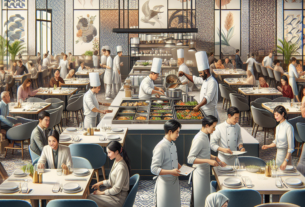Introduction
Restaurant pricing strategies play a crucial role in the competitive landscape of the food service industry. Chains constantly strive to attract customers by offering competitive prices while maintaining profitability. This report will delve into the various pricing strategies employed by restaurant chains to compete on cost.
Current State of the Food Service Industry
According to a recent report by CulinaryCoverage.com, the food service industry is experiencing rapid growth and innovation in 2025. With the rise of technology and changing consumer preferences, restaurants are facing new challenges and opportunities.
Market Share and Competition
The food service industry is highly competitive, with numerous restaurant chains vying for market share. Some of the major players in the industry include fast food chains like McDonald’s, Burger King, and Taco Bell, as well as casual dining chains like Olive Garden and Applebee’s.
Financial Performance
Despite the challenges posed by rising food costs and labor shortages, many restaurant chains have managed to maintain strong financial performance. According to industry reports, the average profit margin for restaurant chains in 2025 is around 10%.
Consumer Trends
Consumer preferences are constantly evolving, with an increasing focus on health, sustainability, and convenience. As a result, restaurant chains are adapting their menus and pricing strategies to cater to these changing trends.
Restaurant Pricing Strategies
Restaurant chains employ a variety of pricing strategies to attract customers and drive sales. Some of the common pricing strategies include value pricing, premium pricing, and psychological pricing.
Value Pricing
Value pricing is a popular strategy among fast food chains, offering customers affordable prices for their meals. For example, McDonald’s Dollar Menu has been a successful value pricing strategy that attracts budget-conscious consumers.
Premium Pricing
On the other end of the spectrum, some restaurant chains opt for premium pricing to position themselves as high-end dining options. These chains focus on providing high-quality ingredients and unique dining experiences to justify their higher prices.
Psychological Pricing
Psychological pricing is a strategy that leverages consumer psychology to influence purchasing decisions. For example, pricing an item at $9.99 instead of $10 creates the perception of a better deal, even though the difference is minimal.
Case Study: McDonald’s
As one of the largest fast food chains in the world, McDonald’s has implemented various pricing strategies to compete on cost. In recent years, McDonald’s has focused on value pricing with its Dollar Menu and McPick 2 for $5 promotions.
Financial Performance
Despite facing challenges from competitors and changing consumer preferences, McDonald’s has maintained strong financial performance. In 2025, McDonald’s reported a revenue of $25 billion, with a net income of $5 billion.
Future Plans
Looking ahead, McDonald’s plans to continue expanding its menu offerings and digital ordering options to attract a broader customer base. The chain also aims to focus on sustainability and health-conscious menu items to meet the evolving demands of consumers.
Conclusion
In conclusion, restaurant pricing strategies are essential for chains to compete on cost in the food service industry. By implementing value pricing, premium pricing, and psychological pricing strategies, chains can attract customers and drive sales while maintaining profitability. As consumer preferences continue to evolve, restaurant chains must adapt their pricing strategies to stay competitive in the market.



